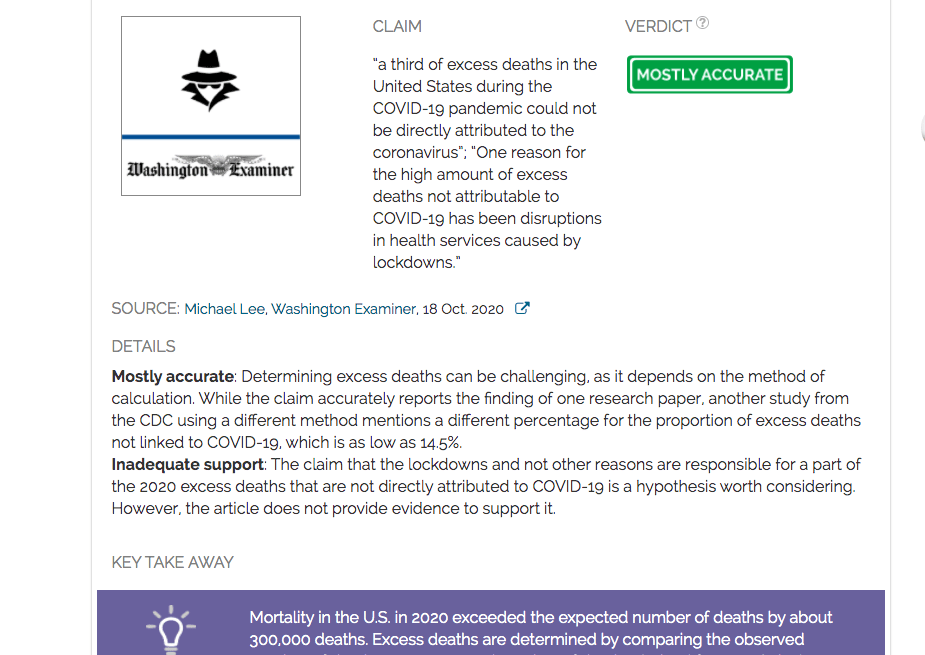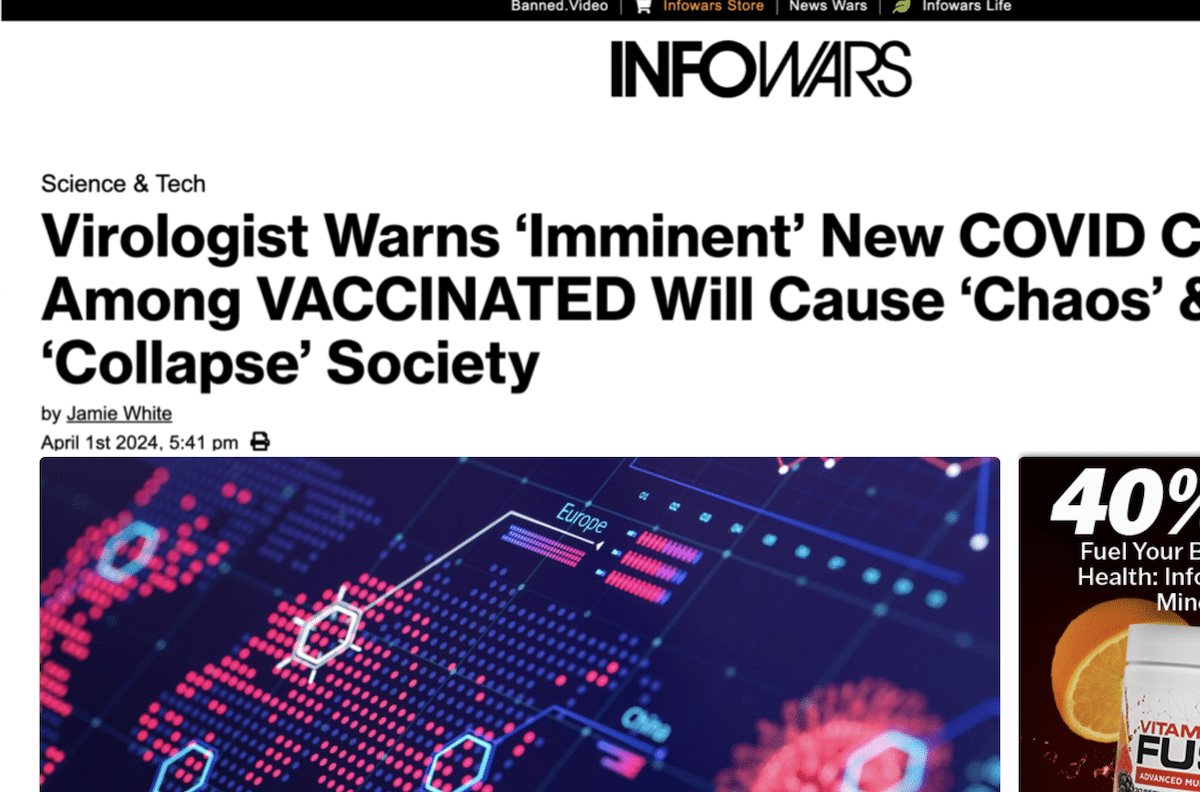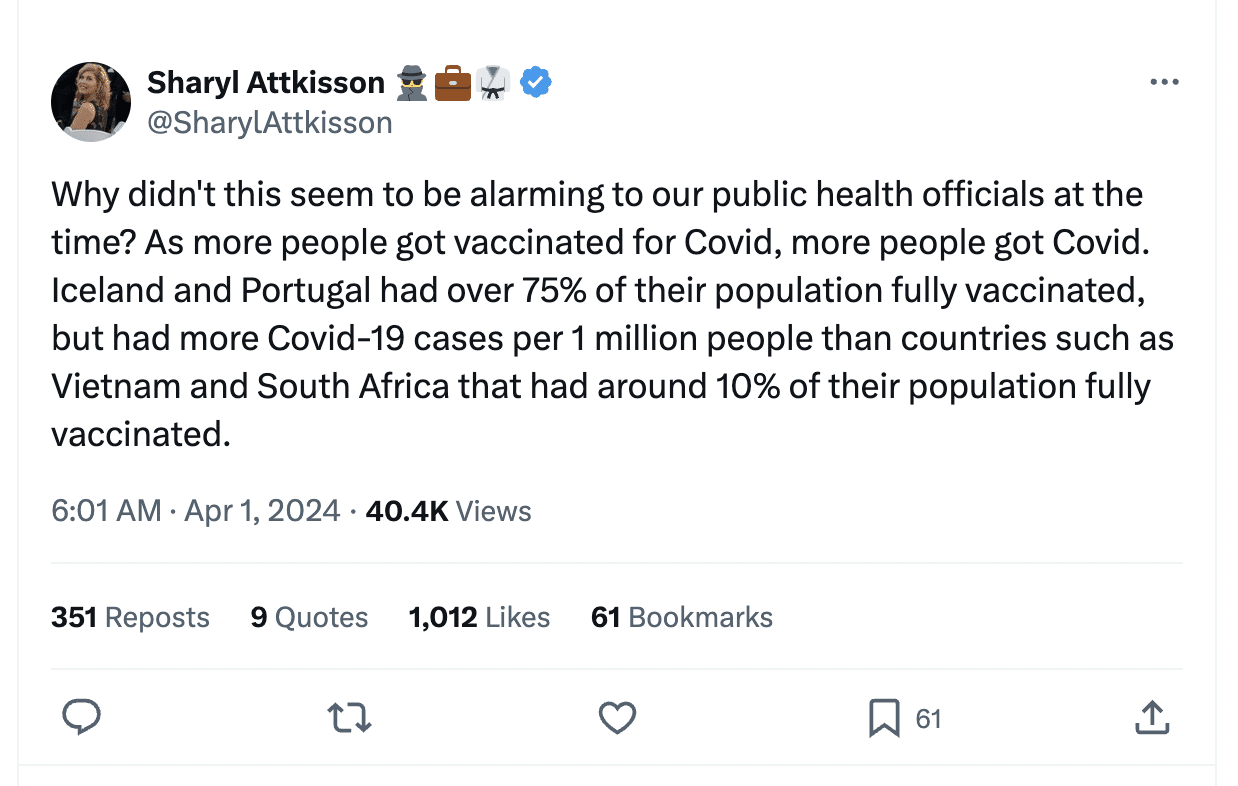- Health
The percentage of excess deaths in the U.S. not directly caused by COVID-19 ranges from 14% to 33%; it remains unclear how lockdowns influenced excess mortality
Key takeaway
Mortality in the U.S. in 2020 exceeded the expected number of deaths by about 300,000 deaths. Excess deaths are determined by comparing the observed number of deaths to an expected number of deaths derived from statistical models. Scientific studies report that 14.5 to 33% of excess deaths are not directly attributed to COVID-19, depending on how the expected number of deaths is calculated. While it is likely that the COVID-19 pandemic and its consequences are indirectly responsible for these non-COVID-19 excess deaths, it is difficult to conclude that measures taken to limit the spread of the virus, such as lockdowns, are responsible due to a lack of data at this point in time.
Reviewed content

Verdict:
Claim:
“a third of excess deaths in the United States during the COVID-19 pandemic could not be directly attributed to the coronavirus”; “One reason for the high amount of excess deaths not attributable to COVID-19 has been disruptions in health services caused by lockdowns.”
Verdict detail
Mostly accurate: Determining excess deaths can be challenging, as it depends on the method of calculation. While the claim accurately reports the finding of one research paper, another study from the CDC using a different method mentions a different percentage for the proportion of excess deaths not linked to COVID-19, which is as low as 14.5%.
Inadequate support: The claim that the lockdowns and not other reasons are responsible for a part of the 2020 excess deaths that are not directly attributed to COVID-19 is a hypothesis worth considering. However, the article does not provide evidence to support it.
Full Claim
“a third of excess deaths in the United States during the COVID-19 pandemic could not be directly attributed to the coronavirus”; “One reason for the high amount of excess deaths not attributable to COVID-19 has been disruptions in health services caused by lockdowns”
Review
A claim that COVID-19 only caused two third of the excess mortality observed in the U.S. in 2020 and that lockdowns are in part responsible for the remaining third circulated in October 2020. One article containing this claim was published by the Washington Examiner.
The Washington Examiner article primarily cites the findings of a scientific study published in the Journal of the American Medical Association (JAMA)[1]. The study examined the number of excess deaths in the U.S. from 1 March to 1 August 2020. Excess death quantifies how many more people have died than expected within a specific time frame.
Excess deaths, or excess mortality, is a useful metric to assess the impact of an epidemic as it takes into account all deaths. Thus, it allows researchers to overcome bias from limitations in detection capabilities that affect other parameters such as the infection fatality ratio, another commonly used metric.
To calculate excess death, the observed number of deaths over a specific period is compared to an estimate of the expected number of deaths, which is calculated based on deaths from previous years during that same period. An increase in deaths relative to the expected number is an indication of an ongoing lethal event, such as an epidemic.
The JAMA research article compared the number of deaths in the U.S. from 1 March to 1 August 2020 and found a 20% increase in mortality, amounting to 225,530 excess deaths. The authors also observed that only 67% of deaths were recorded as being directly due to COVID-19, based on the underlying cause of death registered on death certificates.
A study from the U.S. Centers for Disease Control and Prevention (CDC) corroborates these results[2]. The CDC study compared the number of deaths from 26 January to 23 October in 2020 with an expected number of deaths based on the mortality in 2015-2019, and found an excess of 299,028 deaths. Consistent with the JAMA study relayed by the Washington Examiner, the CDC study also noted that one-third of these deaths were not directly attributed to COVID-19, according to the cause of death on death certificates.
However, the CDC study contains one caveat. As explained above, excess mortality is obtained by subtracting two numbers: the observed number of deaths and the expected number of deaths. Therefore, the number of excess deaths calculated depends on how researchers determine the expected number of deaths.
The CDC study calculated the excess deaths using two different methods which provides a range of excess death estimates. The upper estimate was the aforementioned 299,028 excess deaths while the lower estimate fell to 224,173[2].
More importantly, the number of excess deaths that are not attributed to COVID-19 was only 14.5% when using this lower estimate. As the CDC notes, this lower estimate is more conservative as it “more readily identifies areas experiencing statistically significantly higher than normal mortality”.
Therefore, the Washington Examiner’s claim that one-third of excess deaths seen during the pandemic were not due to COVID-19 is based on accurate, published data. However, it does not accurately convey the level of uncertainty involved in the measurement. Depending on how excess death is calculated, the number of excess deaths not attributed to COVID-19 may decrease to less than 15% of the total of excess deaths.
The Washington Examiner also claims that lockdowns are partly responsible for excess deaths observed in 2020 not directly attributed to COVID-19. However, this claim is unsupported by scientific evidence. Instead, both the JAMA and CDC studies list several possible explanations for these excess deaths, notably “unrecognized or undocumented infection with severe acute respiratory syndrome coronavirus 2.” The JAMA study also highlights “disruptions in health care access or utilization” as another possible explanation for these excess deaths, however it does not attribute disruption in healthcare access to lockdowns, as the Washington Examiner article does.
Another potentially important contributor to disruption in healthcare services is an overloaded healthcare system as a result of the COVID-19 pandemic, which the Washington Examiner article does not acknowledge.
In particular, the JAMA research paper reports a statistically significant amount of excess death due to Alzheimer’s disease and dementia during the period between 6 June and 25 July, when all U.S. states already lifted lockdowns, according to the New York Times. Furthermore, an article in Nature highlights how difficult it is to attribute these “non-COVID-19” excess deaths to a specific factor, whether it is undetected COVID-19, overstretched health systems or lockdown measures. The Nature article also explains that lockdowns may have a reverse effect on mortality by reducing deaths from unnatural causes, such as road accidents, suicides, and crime.
Considering the above, it is unclear whether lockdowns are responsible for some excess deaths in 2020 and scientific studies are required to evaluate this question. However, the Washington Examiner article does not present scientific evidence to support the claim that lockdowns are responsible for a certain proportion of excess deaths. This claim thus remains hypothetical and unsupported at this point in time.
In summary, there have been almost 300,000 more deaths than expected in the U.S. in 2020. The claim that a third of those deaths are not directly attributed to COVID-19 is mostly accurate as several published scientific studies reported such findings. However, this number draws an incomplete picture of the situation, as excess death calculation is influenced by how the expected number of death baseline is defined. For instance, a CDC study reports that only 14.5% of excess deaths were not directly attributed to COVID-19. It is unclear how these other excess deaths relate to the COVID-19 pandemic. While it is possible that lockdowns may have contributed to a certain proportion of excess deaths, no data is presented in the Washington Examiner article to support the claim.
REFERENCES
- 1 – Woolf et al. (2020) Excess Deaths From COVID-19 and Other Causes, March-July 2020. Journal of the American Medical Association.
- 2 – Rossen et al. (2020) Excess Deaths Associated with COVID-19, by Age and Race and Ethnicity — United States, January 26–October 3, 2020. MMWR Morb Mortal Wkly Rep



